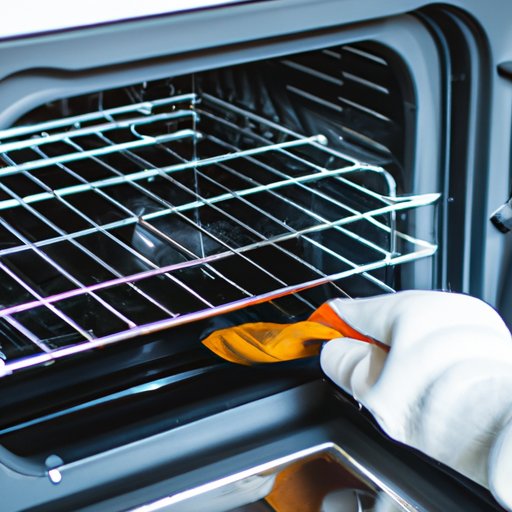Overview of Self-Cleaning Ovens and How They Work
A self-cleaning oven is an appliance that uses extremely high temperatures to burn off food and grease residue on its interior walls. This process is known as pyrolysis and is activated by pressing a button on the control panel. It’s a convenient way to keep your oven clean without having to scrub and scrape away at stubborn messes. But how exactly does it work? Read on to find out.
Definition of a Self-Cleaning Oven
According to the U.S. Department of Energy, a self-cleaning oven is “an oven with a feature that allows it to heat up to very high temperatures (around 880°F) for a set period of time, burning off baked-on food and spills.” When the cleaning cycle is complete, all that’s left is an ash-like material that can be easily wiped away with a damp cloth or sponge.
Explanation of How Self-Cleaning Ovens Work
The self-cleaning process is initiated when the user presses the “clean” button on the oven’s control panel. This activates several components inside the oven, including the thermostat, heating element, and door lock. The thermostat regulates the temperature inside the oven, while the heating element generates the extreme heat necessary for pyrolysis. Finally, the door lock ensures that the oven remains closed during the cleaning cycle.
Explaining the Different Components of a Self-Cleaning Oven
Now that we’ve covered the basics of how a self-cleaning oven works, let’s take a closer look at the individual components involved.
Description of the Oven Door Lock
The oven door lock is an important safety feature that prevents the oven from opening during the self-cleaning cycle. According to Consumer Reports, this lock will engage when the temperature reaches around 600°F and remain locked until the temperature drops to a safe level.
Description of the Thermostat
The thermostat is responsible for regulating the temperature inside the oven during the cleaning cycle. It will usually reach a peak temperature of around 880°F and stay there for two to four hours, depending on the model.

Description of the Heating Element
The heating element is responsible for generating the extreme heat necessary for pyrolysis. This element typically consists of a metal coil surrounded by ceramic insulation and is located at the back of the oven.
Step-by-Step Guide to Using a Self-Cleaning Oven
Using a self-cleaning oven is relatively straightforward, but there are still a few steps you should take to ensure that everything goes smoothly. Here’s a step-by-step guide to using a self-cleaning oven:
Preparation for Self-Cleaning
Before starting the self-cleaning cycle, it’s important to remove any loose food particles and debris from the oven. This can be done by wiping down the interior walls with a damp cloth. It’s also important to make sure that the oven racks are securely in place before beginning the cycle.

Setting the Temperature and Timer
Once the oven is prepared, the user can then set the temperature and timer for the self-cleaning cycle. Most models will allow the user to choose between a two-hour cycle or a four-hour cycle, depending on how much cleaning is needed. The oven will then heat up to the pre-set temperature and remain there for the duration of the cycle.
After Use Precautions
Once the self-cleaning cycle is complete, it’s important to wait at least 15 minutes before opening the oven door. This is to ensure that the oven has had enough time to cool down and that the door lock has disengaged. Once the oven has cooled down, the user can then wipe away any remaining ash-like residue with a damp cloth or sponge.
Benefits of Self-Cleaning Ovens
Self-cleaning ovens offer a number of advantages over traditional ovens, including:
Time Savings
One of the biggest benefits of self-cleaning ovens is the amount of time they can save. According to the U.S. Department of Energy, the self-cleaning cycle can reduce the amount of time spent on oven cleaning by up to 90 percent. This frees up more time for other tasks, such as meal preparation.
Ease of Use
Self-cleaning ovens are incredibly easy to use. All it takes is the push of a button to activate the cleaning cycle. This makes them ideal for busy households who don’t have the time or energy to manually clean their ovens.
Safety
Another major benefit of self-cleaning ovens is the added safety they provide. The door locks and thermostats help to prevent accidental burns and other injuries by keeping the oven closed and regulating the temperature.
Common Questions About Self-Cleaning Ovens
Despite the convenience and safety they provide, there are still some common questions about self-cleaning ovens. Here are a few of the most frequently asked questions:
Is it Safe to Use a Self-Cleaning Oven?
Yes, self-cleaning ovens are perfectly safe to use when operated according to the manufacturer’s instructions. However, it’s important to remember to wait at least 15 minutes after the cycle is complete before opening the oven door.
How Often Should I Use the Self-Cleaning Feature?
Most experts recommend using the self-cleaning feature once every three months. This helps to ensure that the oven remains free of grease and grime buildup, which can lead to food burning on the interior walls.
What Do I Do if My Oven Doesn’t Heat Up During the Cleaning Cycle?
If your oven doesn’t seem to be heating up during the self-cleaning cycle, it’s likely due to a faulty heating element or thermostat. An experienced technician should be able to diagnose and repair the issue.
Conclusion
Self-cleaning ovens are a convenient and efficient way to keep your oven clean. By understanding how they work and taking the proper precautions, you can get the most out of your self-cleaning oven and enjoy its many benefits.
(Note: Is this article not meeting your expectations? Do you have knowledge or insights to share? Unlock new opportunities and expand your reach by joining our authors team. Click Registration to join us and share your expertise with our readers.)
